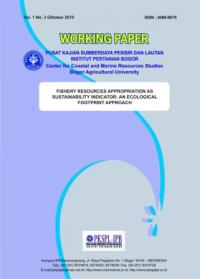FISHERY RESOURCES APPROPRIATION AS SUSTAINABILITY INDICATOR: AN ECOLOGICAL FOOTPRINT Approach

FISHERY RESOURCES APPROPRIATION AS SUSTAINABILITY INDICATOR: AN ECOLOGICAL FOOTPRINT Approach
1. INTRODUCTION
It has been widely known that the most fundamental aspect which is underlying most fisheries theory and practice is that of determining the sustainable yield, i.e. a harvest that can be taken today without being detrimental the resources available in future years (Charles, 2001). In recent period, the focus of fishery
management has been taken on determining a sustainable yield in the form of total allowable catch (TAC). In this regards, maximum sustainable yield (MSY), i.e. the most fish that can be caught each year, year after year, or a lower catch level has been the important icon in the fishery science and type worldwide. From this,
fishery science has evolved as essentially a science of sustainability, with considerable emphasis on the determination of sustainable yields (Schafer, 1954;Beverton and Holt, 1957; Ricker, 1975; and Gulland, 1977).


